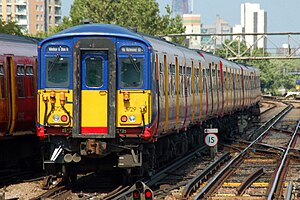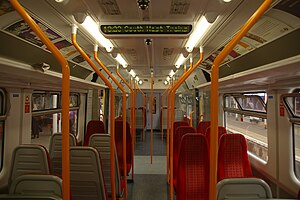British Rail Class 455
| British Rail Class 455 | |
|---|---|

A South West Trains Class 455/7 at Clapham Junction.
|
|

The interior of a South West Trains Class 455 EMU.
|
|
| In service | 1982 - Current |
| Manufacturer | BREL York |
| Family name | BR Second Generation (Mark 3) BREL 1972 "PEP" (Class 455/7 intermediate) |
| Number built | 137 trainsets |
| Formation | 4 cars per trainset |
| Capacity |
|
| Operator(s) | |
| Specifications | |
| Train length | 81.16 m (266 ft 3 1⁄4 in) |
| Car length | 19.83 m (65 ft 3⁄4 in) |
| Width | 2.82 m (9 ft 3 in) |
| Maximum speed | 75 mph (121 km/h) |
| Weight | 135.95 tonnes (133.80 long tons; 149.86 short tons) |
| Electric system(s) | 750 V DC third rail |
| Current collection method | Contact shoe |
| Braking system(s) | Air (Westcode) |
| Track gauge | 1,435 mm (4 ft 8 1⁄2 in) standard gauge |
The British Rail Class 455 is a type of electric multiple-unit passenger train drawing power from a 750 V DC third rail. Built by BREL York works in the early and mid-1980s, they were initially categorised as Class 510 as the successor to the Class 508. They are used on suburban services in South London, by South West Trains and Govia Thameslink Railway (GTR) for Southern services.
There were three batches of Class 455 units, all consisting of 4 cars: driving carriages at each end, an intermediate trailer vehicle and an intermediate motorised vehicle (powered by four EE507-20J of 185 kW carried on the bogies of the MSO vehicle, some recovered from Class 405), all originally built to the Standard Class 3+2 seating arrangement. Technically, they are formed DTSO+MSO+TSO+DTSO. They have the same bodyshell as the Class 317 and Class 318, but as they were designed for inner suburban services they do not feature first class seating, air conditioning or toilet facilities and are restricted to 75 mph (121 km/h). Like the Class 317/318, as well as the diesel Class 150, they are based on British Rail Mark 3 coaches, with a steel construction, unlike the earlier PEP-based Class 313s, 314s, 315s, 507s and 508s, which had an aluminium alloy body.
...
Wikipedia
